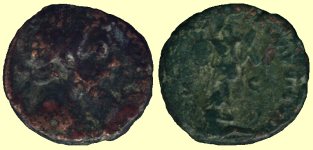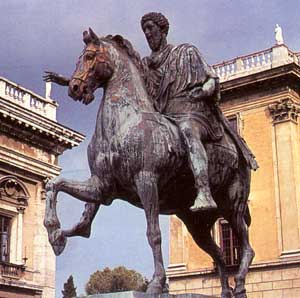
Marcus Aurelius 161 - 180 A.D.
By clicking on the pictures you'll be linked to a more complete description of the coin. At the bottom of this page there is a more elaborate biography of the emperor.
 |
Obverse: M ANTONINVS AVG TR P XXVI |
| Reverse: GERMANIA SVBACTA IMP VI COS II | |
|
Fieldmarks: S C on the reverse
|
|
| Exergue: - |
Marcus Aurelius 161 - 180 A.D.
Marcus Annius Verus was born at Rome on the 26th of April 121 AD as the son of Annius Verus and Domitia Lucilla. His family was quite wealthy and distinguished mainly because of the paternal grandfather, Annius Verus from Uccubi in Baetica, who had brought the family wealth through the production of olive oil and prominence by gaining the rank of senator and praetor. He held the office of consul for no less then three times and served Hadrian as a city praefect. When Marcus' father died at a young age he was adopted and raised by this prominent grandfather. Marcus received an education in rhetoric and philosophy by the best teachers of the day and he was very devoted to his studies. Apparently Marcus was noticed by the emperor Hadrian who took a great interest in the boy and affectionately called him "Verissimus," "Most truthful," as a joke on his name. Hadrian elevated him to equestrian rank at the age of only six and made him a priest of the Salian order only two years later. At the age of 15 Marcus, at Hadrians request, got engaged to Celonia Fabia the daughter of Lucius Ceionius Commodus who was adopted by Hadrian as his successor only a few months later. Being engaged to a daughter of the successor to the emperor made Marcus a very notable political figure. Commodus however wouldn't succeed Hadrian because he died before Hadrian in 138 AD. Hadrian now adopted Antoninus Pius, a very distinguished senator, as his new son and successor but under the condition that he would adopt Marcus Aurelius and Lucius Ceionius Commodus (the orphaned son by the same name) as his sons and heirs. As heirs to the throne the boys changed their names to: Marcus Aelius Aurelius Verus (17 years old) and Lucius Aelius Aurelius Commodus (8 years old) respectively. The reign of Antoninus Pius was one of the most peaceful and prosperous in Roman history. The emperor himself didn't embark on any military undertakings and he never left Italia during his reign. Disturbances at the borders of the empire were dealt with quickly and decisive by legates in charge of the border provinces. As a consequence, neither Caesar gained much military experience. Marcus and Antoninus Pius appeared to have been really fond of each other, like father and son. Eventually Marcus Aurelius broke off his engagement to Ceionia Fabia and instead became engaged to Antoninus' daughter Annia Galeria Faustina (Faustina the Younger) in 139 AD. In that same year Marcus was officially named Caesar and Antoninus' successor. During Antoninus Pius' reign Marcus and Verus were both groomed for their role as successor. Marcus rose steadily through the imperial ranks and held consulates in 140 and 145 and was given tribunicia potestas in 147 all the while keeping up his philosophical and rhetoric studies. He married Faustina in 145 AD and during their 31 years of marriage they got no less than 14 children (most of them would die quite young). Finally in march 161 AD Antoninus Pius died and at the age of 40 Marcus Aurelius was made sole emperor by the senate and took the official name Marcus Aurelius Antoninus (Antoninus out of respect for predecessor and adopted father). However he reminded them of the wills of both Hadrian and Antoninus and his adoptive brother Verus became co-emperor (this was the first time the empire had two Augustii at the same time).
Unlike Antoninus Pius' reign theirs would be a troubled one, immediately starting with barbarian incursions into northern Britannia and Raetia. More importantly in the east the Parthians, Rome's long standing enemy, stirred up trouble along the border with Rome's protectorate, Armenia. The troubles in Britannia and along the Danube were quickly dealt with by legates but the problems in the east demanded the full attention of both emperors. Tensions between Rome and Parthia had been steadily rising during Antoninus' reign and the Parthian King Vologaeses III took his chances with two new inexperienced emperors on the throne. He invaded Armenia and placed a king serving his own interests on the throne. Several armies send by Rome to oppose him were soundly defeated so Marcus Aurelius had to take some serious steps. He send over a large army under the command of his co-emperor Verus to show Rome took this affront very serious. Verus had no military experience but Marcus send some of Rome's best generals to accompany him, chief among them Avidius Cassius. Verus moved to Antioch and in 162 AD the campaign started and was an overwhelming success. First Armenia was recaptured and a new king favorable to Rome was restored to the throne. But this was not enough, Verus and his armies invaded Mesopotamia and several major cities like Seleucia and the Parthian capitol Ctesiphon were plundered and destroyed. By 166 AD Parthia surrendered and a very successful army returned home in triumph, Marcus shared this victory with Verus. During this triumph Marcus gave both his sons Commodus (5 years old) and Annius Verus (3 years old) the title of Caesar. Unfortunately the happy events were overshadowed by a devastating decease the armies had brought back from the east (possibly smallpox, typhoid or the plague). This decease would last for several years and exacted a huge toll in human live on all provinces of the empire.
No sooner had triumphs been celebrated or in 167 AD the Germanic tribes of the Marcomanni and Quadi crossed the Danube and started ravaging the border provinces. Marcus and his brother quickly assembled an army, even drafting slaves because the armies had been severely weakened by the plague and the commitment of troops in newly conquered Mesopotamia. As soon as the barbarians heard that the emperors were on their way they fled back across the Danube, Marcus thought it important to show strength and followed them to the border. On their way back from the border the plague hit their winter camp and both emperors thought it prudent to return to Rome. On the way back Verus died at Altinum in the beginning of 169 AD leaving Marcus Aurelius as sole emperor. Late 169 early 170 the Marcomanni and Quadi came back in even larger numbers, they smashed trough the border provinces once again and moved into Italia itself they burned down Opitergium and laid siege to Aquileia. At the same time further east the tribe of the Costoboci crossed the Danube and drove south into Greece where they got as far south as Eleusis which they plundered. It would take Marcus Aurelius and his decease ridden armies several years of intense fighting and even a battle on the frozen surface of the Danube to drive back these invaders. Marcus' strategy was simple but effective he tried to isolate each tribe and then he either accepted their surrender or destroyed them. For this purpose two new legions were formed II and III Italica, progress was slow but sure and one after the other the tribes were defeated. Marcus resettled a lot of the tribes within the Roman borders giving them land effectively naturalizing them and putting them under Rome's control. They would now pay taxes and supply soldiers for his depleted armies. He also made plans for two new provinces Marcomannia and Sarmatia like Dacia these provinces would reduce the risk of invasions into Rome's territory forming buffers beyond the Danube.
During this great military enterprise Marcus still saw the time to govern the empire in a very effective and efficient way and he found enough time to dedicate to his study of Stoicism a Greek philosophy which he greatly admired. He also wrote a great and very famous book called "Meditations" which contained his deepest thoughts. Marcus' Germanic campaign was only interrupted in 175 AD when Avidius Cassius (one of the generals responsible for defeating the Parthians and now governor of Syria) staged a revolt. Avidius apparently had heard that Marcus had been killed at the northern front and named himself as his successor. Although Avidius had always been a very loyal general Marcus had no choice and immediately moved east. Avidius was killed by his own soldiers even before Marcus arrived. Because the revolt was generally thought to be a misunderstanding and there were strong rumors of the involvement of Marcus' wife Faustina there was no investigation or persecution of any possible instigators. To settle the matter and to prevent anything like this from happening again Marcus named his only living son, Commodus now 16 year old as his co-emperor and successor. With this move Marcus choose his own blood as his heir instead of choosing the most worthy candidate like his predecessors Hadrian and Antoninus Pius had done. Marcus spend several months touring along the eastern provinces showing his face and successor.
After this tour Marcus Aurelius returned to the northern frontier with his son and co-emperor Commodus and continued his Germanic campaign very successfully. Marcus had been suffering from severe stomach and chest pains for some years now and on the 17th of March 180, near Sirmium, Marcus Aurelius died before he could finish his grand design. He had urged his son to continue the campaign and finish the job but Commodus quickly returned to Rome to indulge in its luxuries effectively destroying all of his fathers hard fought successes. Rome would never again fight great expansion wars and its borders would start to come under constant threat from now on.
Marcus Aurelius today still stands strong on
the so-called Capitol Square in Rome, the square was designed by Michelangelo
in 1536 and contains as a focal point the only surviving equestrian statue from
Roman times (it survived the middle ages because it was believed to be a statue
of the first Christian emperor Constantine
the Great). It was made between 161 - 181 AD of bronze and was gilded ,the
horse has his right front leg lifted representing victory over his enemies.
Rather than wearing the usual cuirass, Marcus Aurelius is depicted wearing a
short tunic and patrician boots indicating his civil rather than military functions.
Another surviving monument is the so-called column of Marcus Aurelius, it commemorates
his northern wars (more information on the column can be found here).
His great book "Meditations" can be found online here.
In 166 AD during Marcus Aurelius' reign the first meeting on record between
the Roman and Chinese empire took place as a delegation from Rome laden with
gifts was received at the Chinese capital Luoyang by emperor Huan of the Han
dynasty. In the records Marcus Aurelius is referred to as An-Tun (Antoninus)
of Da-Qin (Rome) which literally means "Great Qin" or Greater China,
Qin being the name of the founding dynasty of the Chinese Empire. In an account
of an expedition to the Roman empire a man named Gan Ying said the following
: "As for the king, he is not a permanent figure but is chosen as the
man most worthy... The people in this country are tall and regularly featured.
They resemble the Chinese, and that is why the country is called Da Qin....
" (for more info on China - Roman relations see here)

For this biography I've used the texts from the following websites:
http://www.imperiumromanum.com/
http://www.roman-emperors.org/
http://www.roman-empire.net/
And from: Gibbon's Decline and fall of the Roman empire.